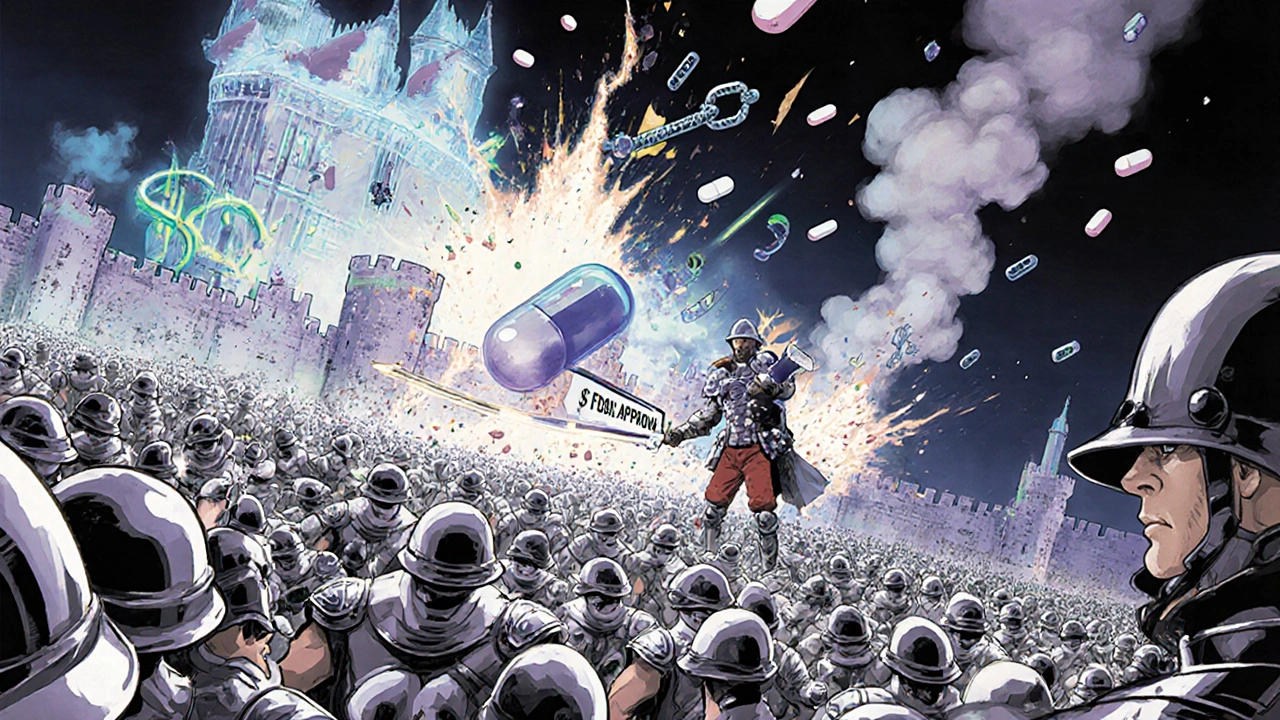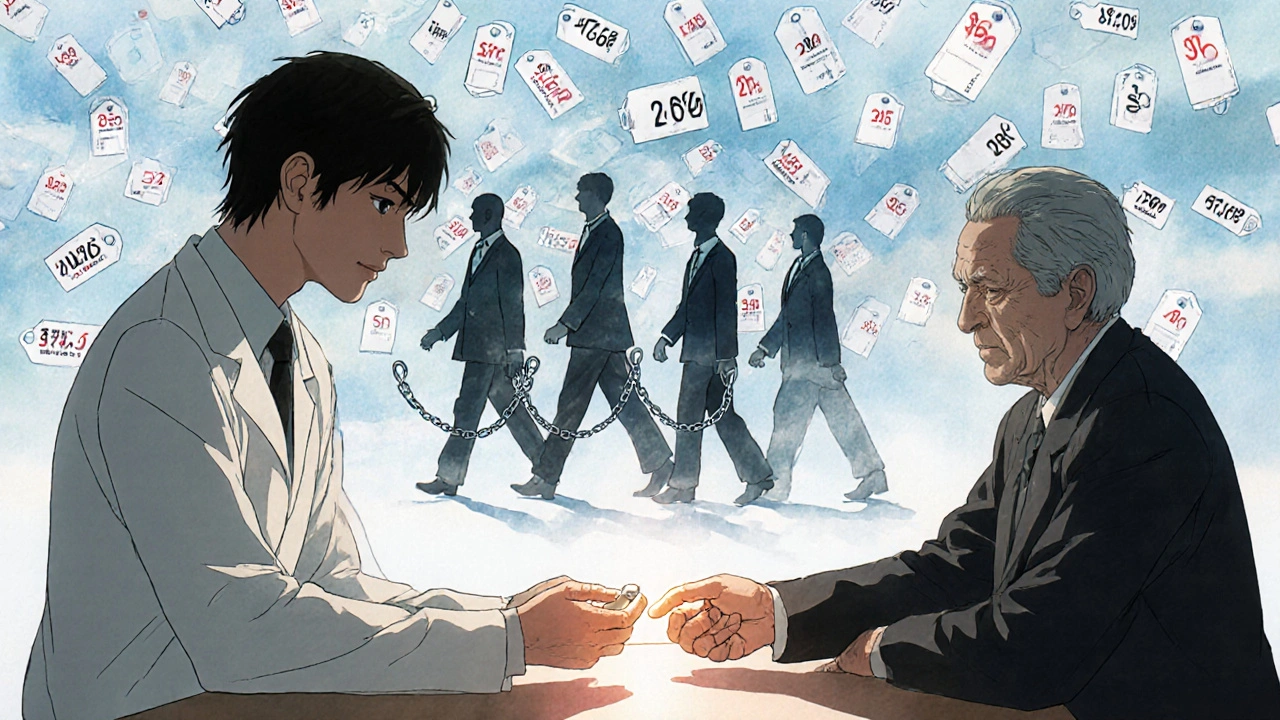Every year, Americans fill over 3.9 billion prescriptions for generic drugs. That’s 9 out of every 10 prescriptions written. And yet, these same generics make up just 12% of total drug spending. Meanwhile, brand-name drugs-only 10% of prescriptions-account for 88% of the money spent. This isn’t a glitch. It’s the system working exactly as designed.
How Much Do Generics Actually Save?
In 2024, the average out-of-pocket cost for a generic prescription was $6.95. For the same medicine in brand form? $28.69. That’s more than four times more. For someone taking three generic medications a month, that’s $208 saved annually just on copays. Multiply that by millions of people, and you get the real story: generic drugs saved U.S. healthcare $445 billion in 2023 alone.
Over the past decade, generics and biosimilars have saved Americans a staggering $3.4 trillion. Think about that. That’s enough to cover the annual healthcare costs for every person in Texas, New York, and California combined. And it’s not just about cash in hand. For uninsured patients, brand-name drugs jumped to $130.18 per prescription since 2019. Generics? They went down by $2.45 over the same period.
The Numbers Behind the Savings
The FDA estimates that just the generic drugs approved in 2022 will save $18.9 billion in the coming years. But that’s just the tip of the iceberg. In 2022, total savings from all generics and biosimilars hit $408 billion. And that number keeps growing-even as the number of generic prescriptions rises.
Between 2015 and 2024, generic oral solid prescriptions increased by 15%. But here’s the twist: total spending on generics dropped by $6.4 billion over that same time. That’s right. More people are using generics, and they’re paying less. That’s the deflationary power of competition.
Compare that to brand drugs. In 2023, three blockbuster medications-Entresto, Tradjenta, and Opsumit-brought in $8.6 billion in sales combined. All three are set to lose patent protection by the end of 2025. When generics hit the market, those numbers will collapse. History shows that within a year of generic entry, prices for these drugs typically fall by 80-90%.
Biosimilars: The Next Wave of Savings
Biosimilars are the generic version of complex biologic drugs-medications made from living cells, like those used for cancer, rheumatoid arthritis, and Crohn’s disease. They’re harder to copy than regular pills, but they’re still cheaper.
Since their introduction, biosimilars have saved the U.S. healthcare system $56.2 billion. In 2024 alone, they saved $20.2 billion. One example: Stelara, a drug for psoriasis and Crohn’s, had a list price of over $6,000 per dose. After nine biosimilars entered the market by July 2025, some versions dropped to as low as 10% of the original price. That’s a 90% discount.
And it’s making a real difference. Oncology spending growth dropped in half since 2019, thanks mostly to biosimilar competition. In 2020, $18 billion was saved on cancer drugs just from biosimilars. Yet, even with all this, biosimilars still make up less than 30% of prescriptions in most markets. There’s room to grow-and billions more to save.

Why Aren’t More People Using Them?
The answer isn’t about safety or effectiveness. The FDA requires generics to be bioequivalent to brand drugs-meaning they work the same way in the body. In fact, less than 1% of patients report noticeable differences between generic brands, according to FDA adverse event data through mid-2025.
The real problem? Patent manipulation. Brand drug companies use tricks like “patent thickets”-filing dozens, sometimes over 75, overlapping patents on a single drug. One drug that should have lost its patent in 2016 got extended to 2034 this way. These legal maneuvers delay generic entry for years.
Another tactic? “Product hopping.” When a patent nears expiration, companies slightly tweak the drug-change the pill shape, switch from a tablet to a capsule-and push patients to the new version. Then they patent that too. It’s not innovation. It’s a delay tactic.
And it’s expensive. Blue Cross Blue Shield estimates “pay-for-delay” deals-where brand companies pay generics to stay off the market-cost consumers $3 billion a year. That’s $12 billion total in added drug costs each year.
What’s Being Done About It?
Lawmakers are starting to act. In early 2025, bipartisan committees advanced two key bills: the Affordable Prescriptions for Patients Act, which targets patent thickets, and the Drug Competition Enhancement Act, which bans product hopping. The Congressional Budget Office says these changes could save $2.9 billion over ten years.
Pharmacy benefit managers (PBMs)-the middlemen who manage drug plans for insurers-are also stepping up. As of January 2025, 87% of commercial health plans now require pharmacists to substitute generics when available. Kaiser Permanente cut pharmacy costs by 25-35% in just 18 months by pushing generics hard.
States are catching up too. Only 42 out of 50 have updated their pharmacy laws to let pharmacists switch to generics without calling the doctor every time. That’s changing slowly. But progress is real.

Who Benefits the Most?
Medicare beneficiaries. Uninsured patients. People on fixed incomes. Families juggling rent, groceries, and prescriptions. The data doesn’t lie: if you’re paying for your own meds, generics are the only way to stay on treatment without going broke.
Take a common drug like metformin for diabetes. The brand version? Around $150 a month. The generic? $4. That’s not a difference in quality. That’s a difference in corporate pricing strategy.
And it’s not just about money. A 2024 study from Harvard Medical School found that patients who switched from brand to generic were more likely to stick with their treatment-because they could actually afford it.
What’s Next?
The FDA approved 745 generic drugs in 2024-a record. And 2025 is on track to beat that. More than 150 companies are now making generics in the U.S., with Teva, Viatris, and Sandoz leading the pack. But the real winners? Patients.
The Department of Health and Human Services has made expanding access to biosimilars a top priority. The goal? Lower costs, more access, better outcomes. The tools are already here. What’s missing is the will to use them.
For now, the message is simple: if your doctor prescribes a brand-name drug, ask if there’s a generic. If your pharmacy says it’s not available, ask why. Chances are, it’s not about science. It’s about profit.
Are generic drugs as safe and effective as brand-name drugs?
Yes. The FDA requires generic drugs to have the same active ingredients, strength, dosage form, and route of administration as the brand-name version. They must also prove they work the same way in the body. Over 90% of generic drugs are rated as therapeutically equivalent. Less than 1% of patients report noticeable differences, and those cases are rare-often tied to narrow therapeutic index drugs like warfarin or levothyroxine, where tiny dose changes matter.
Why are generic drugs so much cheaper?
Generic manufacturers don’t have to repeat expensive clinical trials. Thanks to the Hatch-Waxman Act of 1984, they only need to prove their drug is bioequivalent to the brand. That cuts development costs by 80-90%. Once multiple companies start making the same drug, competition drives prices down. Brand drugs, on the other hand, recover R&D costs through high prices during their patent monopoly-often for 20 years.
Can I trust generics from different manufacturers?
Yes. All generic manufacturers must meet the same FDA quality standards as brand companies. The FDA inspects every facility-whether it’s in the U.S., India, or elsewhere. The pill may look different, or come in a different color, but the active ingredient and how it works are identical. Some patients notice slight differences in fillers or coatings, but these don’t affect how the drug works.
Why does my pharmacy sometimes switch my generic brand?
Pharmacies often switch generic brands to get the lowest price available. Generics from different makers can vary in cost-even if they’re identical in effect. Your insurance plan may push the cheapest option to save money. If you’re concerned, ask your pharmacist if the switch affects your treatment. In most cases, it doesn’t. But if you have a condition like epilepsy or thyroid disease, talk to your doctor before switching.
Will I save money if I switch to a generic?
Almost always. The average generic prescription costs $6.95 out-of-pocket in 2024. The brand version? $28.69. For chronic conditions like high blood pressure or cholesterol, switching can save hundreds-or even thousands-of dollars a year. If you’re paying cash, the difference is even bigger. Always ask your pharmacist for the cash price before you pay. Sometimes the generic without insurance is cheaper than the brand with it.
Are there any drugs where I should avoid generics?
Very few. For most medications, generics are a safe, effective, and affordable choice. The FDA lists only a small number of drugs-like warfarin, levothyroxine, and some seizure medications-as having a narrow therapeutic index, meaning small differences in blood levels can matter. Even then, generics are still approved and used safely by millions. If your doctor says to stick with brand, ask why. Often, it’s habit, not science.


Beth Banham
November 8 2025Just paid $3.50 for my generic metformin at Walmart. My buddy’s brand version was $147 last month. No joke. This isn’t even close to a fair system.